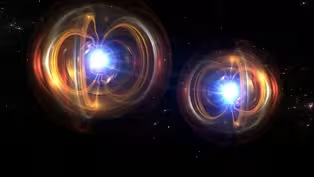
How Atomic Clocks Keep Perfect Time
Clip: Season 51 Episode 14 | 2m 15sVideo has Closed Captions
Atomic clocks use quantum physics and the resonant frequency of atoms, like cesium, to define time.
Modern timekeeping relies on the accuracy of atomic clocks, which revolutionized timekeeping by using the quantum behavior of atoms to measure time. Discover how these incredibly precise clocks work, and how they ensure global synchronization in everything from GPS to scientific research.
Problems playing video? | Closed Captioning Feedback
Problems playing video? | Closed Captioning Feedback
National Corporate funding for NOVA is provided by Carlisle Companies and Viking Cruises. Major funding for NOVA is provided by the NOVA Science Trust, the Corporation for Public Broadcasting, and PBS viewers.

How Atomic Clocks Keep Perfect Time
Clip: Season 51 Episode 14 | 2m 15sVideo has Closed Captions
Modern timekeeping relies on the accuracy of atomic clocks, which revolutionized timekeeping by using the quantum behavior of atoms to measure time. Discover how these incredibly precise clocks work, and how they ensure global synchronization in everything from GPS to scientific research.
Problems playing video? | Closed Captioning Feedback
How to Watch NOVA
NOVA is available to stream on pbs.org and the free PBS App, available on iPhone, Apple TV, Android TV, Android smartphones, Amazon Fire TV, Amazon Fire Tablet, Roku, Samsung Smart TV, and Vizio.
Buy Now

NOVA Labs
NOVA Labs is a free digital platform that engages teens and lifelong learners in games and interactives that foster authentic scientific exploration. Participants take part in real-world investigations by visualizing, analyzing, and playing with the same data that scientists use.Providing Support for PBS.org
Learn Moreabout PBS online sponsorship(dramatic music) - [Narrator] Over the centuries, we've tracked time a variety of ways, but since the 1960s, (clocks ticking) time has been officially determined using atomic clocks and the quantum characteristics of atoms.
The consistency of atomic clocks arises from the very nature of atoms.
- Atomic clocks depend crucially on the quantum physics of atoms.
You have a nucleus (dramatic music continues) around which there are electrons in certain energy levels, and these energy levels of possible energy states that the electron can have inside the atom.
- [Narrator] Since an electron can only be at certain energy levels and not in between, to get to a higher level, it needs to encounter a very specific helping hand, such as a particular photon.
- So if it were to absorb an incoming photon, it would have to be of just the right energy to jump from one level to a higher level.
- [Narrator] That special relationship between the electrons of a particular atom and a photon of a specific energy level is a unique signature for that atom.
It's called a resonant frequency.
- So this characteristic signature of this atom gives us a very specific frequency standard that we can use to build a timekeeping device.
(air whooshes) (dramatic music continues) - [Narrator] Atomic clocks work in different ways, but they all use a specific type of atom or molecule as a reference to lock in the frequency of an electromagnetic wave whose oscillations provide the ticking of the clock.
(waves ticking) (air whooshes) Today, a second is officially defined by counting the oscillations of the primary resonant frequency of a Cesium-133 atom.
That's over 9 billion oscillations per second.
(air warbling)
Decoding the Universe: Quantum Preview
Video has Closed Captions
Preview: S51 Ep14 | 30s | Dive into the universe at the tiniest – and weirdest – of scales. (30s)
The Most Baffling Idea in Physics, Explained
Video has Closed Captions
Clip: S51 Ep14 | 3m 33s | Quantum entanglement defies our everyday understanding of reality. (3m 33s)
Providing Support for PBS.org
Learn Moreabout PBS online sponsorship
- Science and Nature

Capturing the splendor of the natural world, from the African plains to the Antarctic ice.













Support for PBS provided by:
National Corporate funding for NOVA is provided by Carlisle Companies and Viking Cruises. Major funding for NOVA is provided by the NOVA Science Trust, the Corporation for Public Broadcasting, and PBS viewers.




